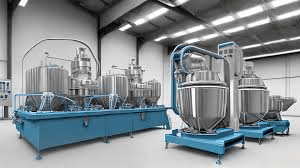RMGs can present several challenges during operation, affecting productivity, product quality, and compliance. This comprehensive guide explores the common challenges associated with rapid mixer granulators and provides effective solutions to optimize their performance.
1. Understanding the Rapid Mixer Granulator
1.1 What is a Rapid Mixer Granulator?
A Rapid Mixer Granulator is an advanced processing machine used for mixing, granulating, and homogenizing powder blends. It comprises three key components: an impeller, a chopper, and a bowl, all of which work together to achieve uniform granulation.
1.2 Working Principle of a Rapid Mixer Granulator
The RMG operates in two main phases:
-
Mixing Phase: The impeller rotates at a controlled speed to mix dry powders thoroughly.
-
Granulation Phase: A binding liquid is introduced, and the chopper Rapid Mixer Granulator helps break down lumps to form consistent granules.
While the machine is highly effective, several challenges can arise during its operation.
2. Common Challenges in Rapid Mixer Granulator
2.1 Poor Granule Uniformity
One of the most prevalent issues with RMGs is poor granule uniformity, which can lead to inconsistent tablet quality.
Causes:
-
Uneven distribution of binding solution
-
Improper mixing time and speed
-
Incorrect powder-to-liquid ratio
Solutions:
-
Optimize the addition rate and distribution of the binding solution
-
Adjust impeller and chopper speeds to ensure thorough mixing
-
Conduct pre-formulation studies to determine the ideal liquid-to-solid ratio
2.2 Overwetting or Underwetting of Granules
Proper wetting is essential for achieving optimal granule strength. Overwetting can cause excessive stickiness, while underwetting leads to weak granules.
Causes:
-
Excessive or insufficient binder solution
-
Poor control of spraying mechanism
-
Variations in binder viscosity
Solutions:
-
Use precise liquid addition methods, such as peristaltic pumps
-
Monitor the binder’s viscosity and adjust accordingly
-
Optimize spray nozzle design for even distribution
2.3 Excessive Heat Generation
High temperatures during granulation can degrade sensitive pharmaceutical ingredients.
Causes:
-
Prolonged impeller and chopper operation
-
High-speed rotation of components
-
Poor cooling system
Solutions:
-
Optimize granulation time to minimize heat exposure
-
Use jacketed bowls with a cooling system
-
Reduce the rotational speed where possible
2.4 Sticking and Caking of Material
Granules sticking to the walls or blades can lead to inconsistent product quality and machine downtime.
Causes:
-
Overwet granules adhering to surfaces
-
High binder concentration
-
Improper blade or bowl design
Solutions:
-
Optimize the binder concentration to prevent excessive stickiness
-
Use non-stick coatings on blades and bowl interiors
-
Implement timely machine cleaning protocols
2.5 High Powder Loss During Granulation
Loss of fine powder during the mixing and granulation process can reduce product yield and increase production costs.
Causes:
-
Poor sealing of the granulator
-
High-speed mixing causing dust formation
-
Ineffective powder charging technique
Solutions:
-
Use properly sealed RMG systems to prevent material loss
-
Optimize mixing speed to reduce dusting
-
Improve material feeding techniques
2.6 Machine Downtime and Maintenance Issues
Frequent breakdowns and maintenance issues can disrupt production schedules and increase costs.
Causes:
-
Worn-out impellers and choppers
-
Poor lubrication and maintenance practices
-
Electrical and mechanical failures
Solutions:
-
Implement regular preventive maintenance programs
-
Lubricate moving parts as per manufacturer recommendations
-
Train operators to identify early warning signs of machine failure
3. Advanced Troubleshooting Techniques
3.1 Process Optimization Strategies
To enhance the performance of RMGs, manufacturers can:
-
Use Design of Experiments (DOE) to fine-tune granulation parameters
-
Implement real-time monitoring systems for better process control
-
Adopt automated binder addition techniques for precise dosing
3.2 Cleaning and Validation Procedures
Proper cleaning and validation are critical to maintaining product quality and regulatory compliance.
Best Practices:
-
Use Cleaning-in-Place (CIP) systems for efficient cleaning
-
Follow Good Manufacturing Practices (GMP) guidelines
-
Validate cleaning methods to prevent cross-contamination
4. Future Trends in Rapid Mixer Granulation
4.1 Automation and Digitalization
The adoption of smart RMGs equipped with IoT sensors and real-time monitoring capabilities is improving process efficiency and reducing manual errors.
4.2 Sustainable Granulation Techniques
Manufacturers are exploring greener granulation methods, such as water-based binders, to reduce environmental impact.
4.3 AI-Driven Predictive Maintenance
Artificial Intelligence (AI) is being utilized to predict machine failures and optimize maintenance schedules, thereby minimizing downtime.
5. Conclusion
The Rapid Mixer Granulator remains an essential tool in pharmaceutical and industrial granulation processes. However, operational challenges such as granule uniformity, heat generation, and machine maintenance require careful attention. By understanding common issues and implementing effective solutions, manufacturers can enhance efficiency, ensure high product quality, and maintain regulatory compliance.
Continuous innovation, process optimization, and the integration of advanced technologies will further improve the reliability and performance of rapid mixer granulators, making them more efficient and user-friendly for future manufacturing needs.



